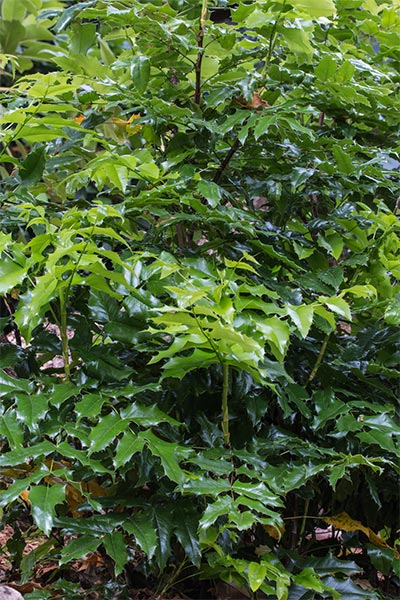Tall Oregon Grape
- Scientific Name: Berberis aquifolium
- Garden: Beneficial Insects and Compost Garden, Natives Garden, Wildlife Garden
- Plant Type: Shrub
- Evergreen/Deciduous: Evergreen
- Sun/Shade Exposure: Part Sun to Part Shade
- Moisture Requirements: Moist, Well-Drained
Plant Information
This woodland beauty is Oregon's state flower. It is the tallest of the native species, sometimes reaching up to ten feet, though more often in garden settings staying four-to-five feet tall; upright, sometimes slightly arching branches covered with the prickliest of leaves – a good candidate for a hedgerow or back of a garden bed.
Give it some space, for the tough rhizomes can have it spreading to a richly textured evergreen thicket that is a wonderful protective site for birds. The effects of cold, sun and even age, will cause leaves to take on shades of red to nearly purple, providing a rich tapestry of color when joined with the bronze-red color of its new growth, the bright yellow of the flowers and the dusky blue of the berries.
Mahonia aquifolium can easily withstand the dry shade under large trees, though also tolerant of moist (not wet) conditions. It can grow in full sun, but will suffer if not given some shade where summers are hot, even with more regular water. All in all, a beautiful, adaptable, bird-friendly addition to many garden settings.
Native Range: One or more of the four native species of Mahonia can be found in almost every county in Oregon; common along the entire west coast and eastward toward the Rockies.
Characteristics: Evergreen woody-stemmed shrubs with distinct holly-like leaves. Bronze-colored new growth in spring, with mounds of small, bright yellow fragrant flowers in spring, followed by clusters of round, dusky blue (edible, though often sour) fruit. Foliage often takes on a striking red to purplish cast in fall-winter.
Culture: Grows best in partial sun — though some species can thrive in full shade to full sun — rich acidic soil, and to moist to dry conditions. Avoid planting Oregon grape in soil that is compacted, wet, or too alkaline; plants should also be protected from winter winds.
Pests/Diseases: Leaves can become chlorotic in soil that is too alkaline, and can suffer leaf-burn in winter winds. Occasionally some leaf spot in too-wet conditions, but virtually pest and disease free. Leaves can become chlorotic in soil that is too alkaline, and can suffer leaf-burn in winter winds. Occasionally some leaf spot in too-wet conditions, but virtually pest and disease free.
Data Source
portlandnursery.comPlant Photos





